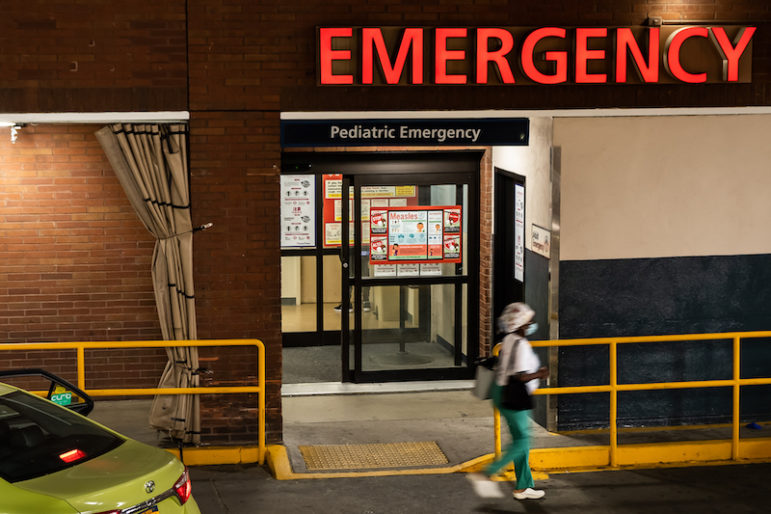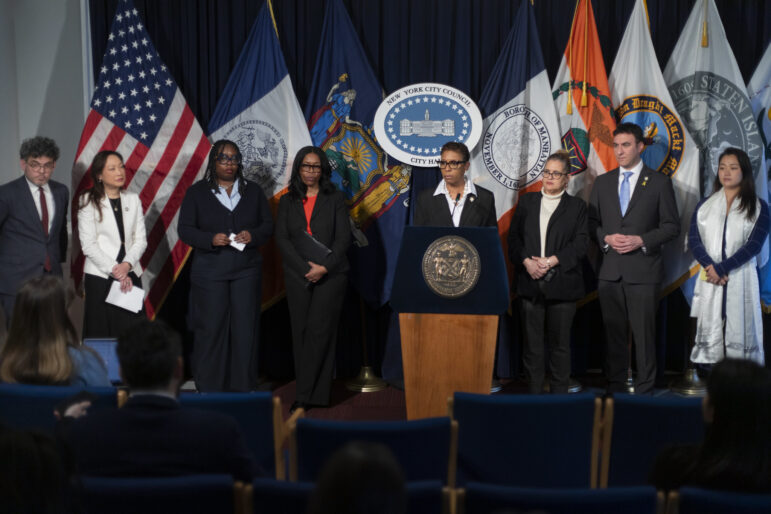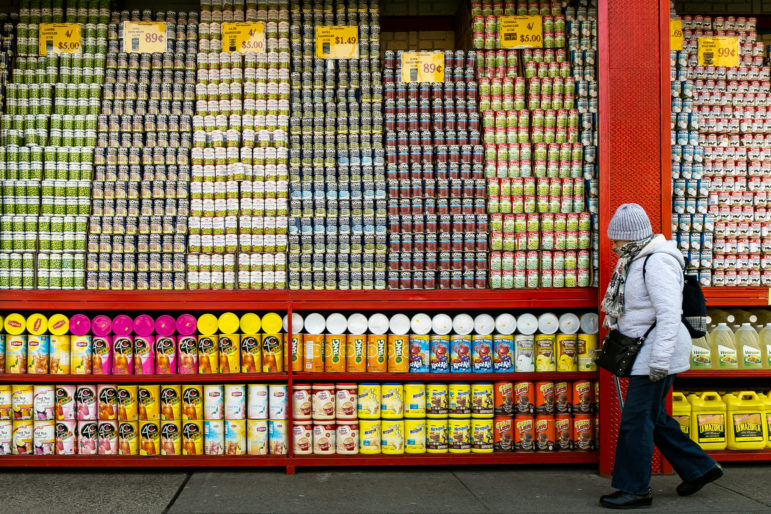
Adi Talwar
Wanda Ruiz teaching her universal Pre-K class for 4 to 5-year-old children at the Chung Pak Day Care Center on Walker Street in downtown Manhattan. Ruiz, who has 25 years of teaching experience, has been at the center for four years.
Bundled against the harsh January cold, the little girl was but a pair of dark eyes staring out from under a wool cap and scarf as her father whisked her from an idling car into the squat building wedged among Lower East Side high-rises. There was no time to waste getting inside that Friday morning. There were blocks to be played with and pictures to color. A massive rabbit twitching its nose in a corner needed to be cooed at. The plastic carrots and peppers in the play kitchen were not going to cut themselves.
Inside Little Star of Broome Street, director Mary Cheng led a homesick girl by the hand from one of the four classrooms into the family lounge, where five mothers were chatting and eating breakfast, to visit the bunny. Then Cheng entered a second classroom and was nearly tackled by hugs from students as she received updates from two staff members inside about which students were a little sick and which were a little sad that day. The hallway was a colorful mix of hanging coats, tiny boots and brightly decorated bulletin boards. The names on the student cubbies near the classroom door were mostly Chinese – here was Lin, there was Wang – but Vega and Lopez were there, too.
Little Star looked just like any New York City school. Only it isn’t one—it’s a private facility run by a community-based organization, or CBO. In the early-childhood education expansion that has been Bill de Blasio’s greatest triumph as mayor, places like the building on Broome Street have played just as important a role as facilities run by the city’s school system: About half of the 70,000 students in Universal Pre-Kindergarten attend programs run out of CBOs, not schools.
Staff at places like Little Star, however, make significantly less than their counterparts in the school system—as much as $33,000 less a year, according to data from the Citizens’ Committee for Children. That disparity has long irked CBOs and their allies who say it is unfair to workers and destabilizing to programs.
Now, the de Blasio administration is on the verge of a major restructuring of the way early-childhood education is run in New York. Through a request for proposals that will be issued soon, the city will move its infant childcare initiative EarlyLearn and some HeadStart programming from the Administration from Children’s Services into the Department of Education, where it will be part of the same framework as UPK and 3-K, the mayor’s new and expanding education program for three-year olds. The result will be a birth-to-five system whose parts work in concert to give kids what they need.
CBOs see the RFP as a chance for the mayor to address the pay disparity that, ironically, has long been at the heart of his flagship program to fight inequality. But so far, the administration isn’t saying whether it will take the expensive step of moving CBO teachers’ salaries to align with those in schools.
The DOE told City Limits this week that it has listened carefully to feedback about many elements of the proposal, which it began previewing late last year, and heard the concerns about salaries. But as the mayor prepared to unveil his fiscal 2020 preliminary budget on Thursday, the administration was making no commitment to spend what it would take to bring CBO salaries in line with schoolteachers’.
“Bringing early education programs under the DOE will support quality and make enrollment easier for children, families, and providers citywide,” Isabelle Boundy, an assistant press secretary at the DOE, told City Limits in a statement. “We’ve worked closely with community-based providers to make Pre-K and 3-K for All a reality, and these providers continue to play a critical role as we take this exciting next step. We deeply value our early educators and will continue to work with our providers to recruit, retain, and grow a talented workforce.”
There’s at least some political support for pushing the administration to do something more concrete to address the pay disparity. “In my opinion, it’s one of the main outstanding issues that we have not addressed in the last five years. It has to be addressed,” says Councilmember Stephen Levin, the chair of the Council’s general welfare committee. “It’s something that has to be looked at comprehensively. It’s a great opportunity during this time to do that because of the RFP.”
The RFP would affect contracts that cover the 2020-2021 school year and beyond. DOE says CBOs will continue to play an important role in the unified 0-to-5 system. Right now, that system includes about 30,000 EarlyLearn students, roughly 70,000 children in UPK, and another 5,000 or so in the 3-K program. The plan is for 3-K to expand—it will be available in 12 districts in the school year beginning next September, and 14 by the 2020-2021 school year, when it will cover about 20,000 students. The mayor hopes to take 3-K citywide by the 2021-2022 school year, but that’s going to require significant state and federal investment.
The salary disparity reflects the fact that teachers in CBOs and those at DOE schools belong to different unions. DOE teachers are part of the powerful United Federation of Teachers, while CBO teachers belong to the weaker DC1707. And the pay gap also reflects history: Under Mayor Bloomberg, salaries for CBO teachers didn’t budge for a decade as City Hall let the contract for those workers lapse into limbo. In 2016, de Blasio updated the deal and CBO teachers received significant raises; their starting salary will now reach $50,000 for teachers with a master’s degree. The city also created a bonus for lead teachers.
But the deal didn’t really address the disparity between CBO and DOE teachers, which is significant in a teacher’s first years on the job and grows mightily over time.
And that’s how the disparity really affects CBOs—in retention. “It’s getting harder and harder to entice teachers to stay with us,” Cheng says. “Every year I feel like I’m doing the same staff trainings again because I have to orient the new staff.” She’s lost five teachers in eight years, which is a significant amount of turnover for a four-classroom school. (Little Star is operated by the Chinese-American Planning Council, which also runs other sites under city early-education contracts, including the Chung Pay Day Care on Walker Street.)
Cheng says the turnover affects program stability, which can make it harder to recruit families to enroll there, leaving a program under-subscribed and receiving even less revenue that it planned on. When the school ends up filling fewer seats than it planned, it creates a budget imbalance. Last year, an enrollment shortfall led Little Star to fall three months behind on rent. They had to fundraise to keep the lights on.
“The biggest issue with everything being taken over by the DOE is that these staff members will not become DOE employees,” says Brittney Melvin, who was a pre-school teacher and then an administrator and is on the verge of opening her own pre-school in East Harlem. She says she’s been pushing staff members to go and get higher qualifications, but worries that she won’t be able to retain them once they do.
While individual teachers can display fealty to the mission of a school, it’s not practical for administrators to expect that esprit de corps to hold an institution together. “As a teacher, they always say, ‘Don’t get into education for the money. It can’t ever just be a job to you,'” Melvin says. “As a director, as an administrator, honestly—and this is definitely from experience—I have met a lack of focus. I’ve met resistance. Employees feel, ‘Why do I need to do all that work? You are not paying me enough to be able to carry out this work.'” The fact that non-DOE teachers tend to work longer school days and school years doesn’t exactly sweeten the CBOs’ pitch to workers.
“I guess it all depends on the individual,” Melvin says. “You can’t live without pay.”
Advocates for CBOs contend their programs have maintained high quality despite the retention challenges, and depict the issue as primarily about justice. “In many ways, I feel like the absence of parity is a value statement,” says Jennifer March, the executive director of the Citizens’ Committee for Children. The de Blasio administration has been incredibly progressive and, March says, the pay-parity issue connects to many of the themes the mayor has articulated during his tenure. “It’s about upward mobility for the workforce. It’s about fair compensation for Black and Latina women. It’s about, are we fairly funding the program that serves poor families in the city? I feel it’s a bigger issue than simply parity. It’s an opportunity to make good on a progressive agenda.”
Proponents of salary parity say they do not have a reliable estimate for what it would cost, but it is safe to say the price-tag would be hefty. The city already spends $870 million annually on pre-K and has projected a cost of $500 million for bringing EarlyLearn into the DOE, with state and federal support paying for much of that. De Blasio has estimated the cost of a citywide program for three-year-olds would be another $700 million a year.
A significant increase in the cost of the program could be cast as a choice: continue to expand the reach of the city’s childhood initiative or give fair wages to the teachers who staff it. March doesn’t think those goals are exclusive. “If the ambition is to make sure that greater numbers of children are prepared for school in this city, a parallel goal that is necessary for the success of that initiative is to make sure you’re fairly compensating the workforce,” March says. “I would not back away from expansion effort just because parity is expensive.”
Pay is not the only question nonprofit education providers have about the DOE takeover. There are also concerns about how the program will work for entities that serve more than one age group, and also how seamless the new system would really be. The DOE has gone to some lengths to answer those questions. After issuing the RFP preview in November, it released last week a set of responses to common concerns about it.
Once complete, the move to an integrated 0-to-5 system will be fairly monumental. But it will be complicated—and costly—to get there. Says Cheng: “I really commend DOE for taking this on.”
And taking it on means dealing with the salary issue, according to Levin. “It’s going to be expensive but we can’t have a two-tiered system where the people who are putting in longer hours are getting paid far less,” he says. “That is so detrimental to the system as a whole, and it’s not really sustainable.”








3 thoughts on “Teachers Push De Blasio for Pre-K Pay Equity as New Era for System Approaches”
It is important to note that DC 1707 only represents a small percentage of the CBO workforce. The majority of teachers and staff in CBOs throughout the city are not part of any union.
Pingback: New raises continue to leave some New York City pre-K teachers behind
What about catholic schools with doe upk programs? Will these programs get the incentive?